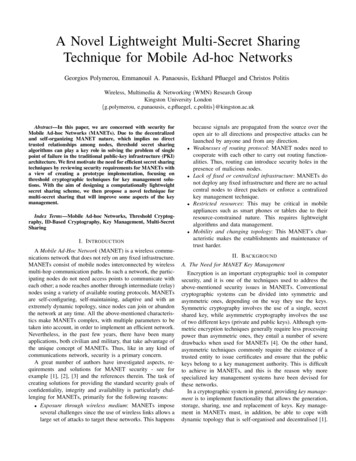
Transcription
A Novel Lightweight Multi-Secret SharingTechnique for Mobile Ad-hoc NetworksGeorgios Polymerou, Emmanouil A. Panaousis, Eckhard Pfluegel and Christos PolitisWireless, Multimedia & Networking (WMN) Research GroupKingston University London{g.polymerou, e.panaousis, e.pfluegel, c.politis}@kingston.ac.ukAbstract—In this paper, we are concerned with security forMobile Ad-hoc Networks (MANETs). Due to the decentralizedand self-organizing MANET nature, which implies no directtrusted relationships among nodes, threshold secret sharingalgorithms can play a key role in solving the problem of singlepoint of failure in the traditional public-key infrastructure (PKI)architecture. We first motivate the need for efficient secret sharingtechniques by reviewing security requirements for MANETs witha view of creating a prototype implementation, focusing onthreshold cryptographic techniques for key management solutions. With the aim of designing a computationally lightweightsecret sharing scheme, we then propose a novel technique formulti-secret sharing that will improve some aspects of the keymanagement.Index Terms—Mobile Ad-hoc Networks, Threshold Cryptography, ID-Based Cryptography, Key Management, Multi-SecretSharingI. I NTRODUCTIONA Mobile Ad-Hoc Network (MANET) is a wireless communications network that does not rely on any fixed infrastructure.MANETs consist of mobile nodes interconnected by wirelessmulti-hop communication paths. In such a network, the participating nodes do not need access points to communicate witheach other; a node reaches another through intermediate (relay)nodes using a variety of available routing protocols. MANETsare self-configuring, self-maintaining, adaptive and with anextremely dynamic topology, since nodes can join or abandonthe network at any time. All the above-mentioned characteristics make MANETs complex, with multiple parameters to betaken into account, in order to implement an efficient network.Nevertheless, in the past few years, there have been manyapplications, both civilian and military, that take advantage ofthe unique concept of MANETs. Thus, like in any kind ofcommunications network, security is a primary concern.A great number of authors have investigated aspects, requirements and solutions for MANET security - see forexample [1], [2], [3] and the references therein. The task ofcreating solutions for providing the standard security goals ofconfidentiality, integrity and availability is particularly challenging for MANETs, primarily for the following reasons: Exposure through wireless medium: MANETs imposeseveral challenges since the use of wireless links allows alarge set of attacks to target these networks. This happens because signals are propagated from the source over theopen air to all directions and prospective attacks can belaunched by anyone and from any direction.Weaknesses of routing protocol: MANET nodes need tocooperate with each other to carry out routing functionalities. Thus, routing can introduce security holes in thepresence of malicious nodes.Lack of fixed or centralized infrastructure: MANETs donot deploy any fixed infrastructure and there are no actualcentral nodes to direct packets or enforce a centralizedkey management technique.Restricted resources: This may be critical in mobileappliances such as smart phones or tablets due to theirresource-constrained nature. This requires lightweightalgorithms and data management.Mobility and changing topology: This MANET’s characteristic makes the establishments and maintenance oftrust harder.II. BACKGROUNDA. The Need for MANET Key ManagementEncryption is an important cryptographic tool in computersecurity, and it is one of the techniques used to address theabove-mentioned security issues in MANETs. Conventionalcryptographic systems can be divided into symmetric andasymmetric ones, depending on the way they use the keys.Symmetric cryptography involves the use of a single, secretshared key, while asymmetric cryptography involves the useof two different keys (private and public keys). Although symmetric encryption techniques generally require less processingpower than asymmetric ones, they entail a number of severedrawbacks when used for MANETs [4]. On the other hand,asymmetric techniques commonly require the existence of atrusted entity to issue certificates and ensure that the publickeys belong to a key management authority. This is difficultto achieve in MANETs, and this is the reason why morespecialized key management systems have been devised forthese networks.In a cryptographic system in general, providing key management is to implement functionality that allows the generation,storage, sharing, use and replacement of keys. Key management in MANETs must, in addition, be able to cope withdynamic topology that is self-organised and decentralised [1].
TCScheme(3,8)Fig. 1.The concept of threshold cryptography.A variety of key management schemes can be found in theliterature [5]. The seminal paper [6] suggests using thresholdcryptography in order to create a distributed public/private keysystem. Later, the concept of Identity-based cryptography wasdeveloped which simplifies the key management process andreduces memory storage cost. We briefly review these conceptsin the next section, before we explain their combined use formodern MANET key management.techniques. Consequentially, it lends itself well to the usewithin a MANET key management.Fig. 2 represents a generic ID-Based scheme, in which NodeA uses the public key of node B (IDB ) and the public keyof the PKG (KP KG ) to cipher a message M. Then, Node B, in order to decrypt the cipher text, uses its private key (KB),received from the PKG.B. Threshold and Identity-Based CryptographyC. Threshold & ID-based Combination for Key Managementin MANETsThe main idea of Threshold Cryptography (TC) is to enhance trust by distributing it among a set of n entities, whichare called shareholders. A TC scheme makes it possible forn shareholders to share the ability to perform a cryptographicoperation (i.e. encryption/decryption, digital signing etc.). Additionally, there is a threshold value t n associated with thescheme with the property that any number k t of the nparties can execute the desired cryptographic operation, butfewer than t parties will not be able to do this by themselves[7]. Such solutions are referred to as (t, n) TC schemes.Let us consider a secret S in n different shares Si ,(i n),so that the knowledge of at least t shares is required andsufficient to recover the initial secret S (see Fig. 1 ). Thresholdmodels can be divided into single secret sharing thresholde.g. Shamirs t-over-n scheme based on Lagranges interpolation, and threshold sharing functions, such as geometricbased threshold. These schemes are being used to implementthreshold variants of RSA, El Gamal and Diffie-Hellmancryptographic algorithms [8]. By nature, TC schemes are idealtools for MANETs where the individual nodes of the networkare the shareholders of the scheme, and single nodes cannotbe trusted.Shamir was the first to introduce the concept of IdentityBased Cryptography (IBC) [9]. The idea in IBC is that eachuser which wants to establish a security association (SA)with another user, can generate the latters public key basedon publicly available identity information (for example, anIP address, email etc.), while the private key is generatedby a trusted third party (TTP), called private key generator.This approach of key management is simpler and has reducedmemory storage cost compared to conventional public keyThe concepts of TC and IBC have been combined in orderto form a variety of key management schemes for MANETs[10], [4], [11], [12], [13], [9]. The concepts of TC and IBChave been combined in order to propose a variety of key management schemes that are adequately efficient for MANETs[10]. In the following, we discuss the most important of theseschemes found in the literature.The Identity-based key management (IKM) presented in [4],uses the above mentioned combination, where each node’spublic and private key are generated by a node-specific IDBased element and a network-wide common element. IKMinvolves three phases: key predistribution (during the networkinitialization), key revocation (in order to minimize the damagefrom compromised nodes), and key update (keys updatesin periodic intervals or when the number of revoked nodesreaches a predefined value).The scheme proposed in [11] consists of two operations:distributed key generation (providing the networks master keyand the key pair for each node) and identity-based authentication (providing end-to-end authentication and confidentiality).Here, all network’s nodes form a distributed PKG set. Thus,each node, in order to obtain its private key must contact atleast t nodes of the PKG; each PKG node generates a secretpart of that private key and sends it back to the requestingnode.The self-organised identity-based authentication and keyexchange (IDAKE) in [12], involves symmetric cryptographyand pairing-based keys specified in six functions: setup, extract, distribute, shared key computation, key renewal, and keyrevocation. All these functions are performed by the network
Fig. 2.The concept of Identity-based cryptography.nodes themselves, without any external PKG, which has beenreplaced by a t-over-n TC scheme.Finally according to the key management scheme proposedin [13], all of the nodes form a distributed PKG set like[11], called threshold PKG, which has a master private keydistributed in a t-over-n TC scheme. The nodes’ public keysare their identities, while their private keys must be computedby the nodes of the threshold PKG. The scheme assumes thatidentities are recorded in hardware and cannot be altered.Despite the fact that some of the above-mentioned techniques establish TC and IBC based certificateless publickey management schemes for MANETs, many issues remainto be resolved. First of all, due to the nature of TC, thesecurity of the entire network is breached when a thresholdnumber of nodes-shareholders are compromised. In addition,updating keys requires each node to individually contact athreshold number of shareholders, which causes a significantcommunication overhead in a large scale MANET. Moreover,all schemes using IBC suffer from the fact that the private keyof each node is computed and hence known by PKG.Last but not least, ID-based schemes lack anonymity andprivacy preservation, as public keys are directly derived fromthe identity of the participating nodes. All the followingaspects contribute to the overall performance of a securitysolution for MANETs: The efficiency of the cryptographic techniques; The secret sharing method; The traffic required for maintaining the key management.D. Secret SharingSecret sharing is at the heart of any asymmetric keymanagement system that is based on threshold cryptography.There are three main techniques for secret sharing: Shamirsscheme [14] based on polynomial interpolation, Blakleyssecret sharing based on solving linear systems [14] and anapproach based on the Chinese Remainder Theorem [15]. Anoverwhelming number of additional secret sharing schemesexist in the literature [16], which refine or improve variousaspects that might arise in different scenarios.Multi-secret sharing (or also referred to as multiple secretsharing) is concerned with the continuous sending of differentsecrets, by updating shares correspondingly. It can also be usedfor sharing large secrets, as they can be divided into severalsmaller secrets and be shared using multi-secret sharing.Usually, this is implemented using particular online secretsharing methods.For the application we are planning to implement, a specifictype of secret sharing (online secret sharing), will be particularuseful. In online secret sharing [17], apart from the shares thatare distributed amongst the players, additional information is“posted on a bulletin board”. Effectively, this information ispublished in an authentic manner but without the need for confidentiality. Online secret sharing is useful for MANETs dueto it can replace the need for encrypting the above additionalinformation and securely distribute it among MANET nodes.E. Our ContributionIn this paper, we focus on providing a secret sharingapproach that minimizes the size of shares as much as possible.We will inspire ourselves from recent work based on multisharing and matrix-projection [18], [6], [19] in order to findan alternative method that offers certain advantages.We will further explore the multi-secret sharing aspect withthe vision to apply our proposed method in a particular clusterbased architecture for MANETs such as the one proposed in[20]. In this kind of clustered topology, a node with moresecurity privileges, called cluster head could be responsiblefor the generation, distribution and renewal of secret shares.III. P ROPOSED M ETHODAs part of a TC scheme, employed within a MANET keymanagement system, one needs to address the method used forsecret sharing. In this paper, we propose an online multi-secretsharing method, which in terms of reducing the share size,is comparable with [18], [6]. Due to its lightweight nature,we expect higher performance than standard secret sharingtechnique, once implemented.Let us consider a secret s, to be distributed into n differentshares si (1 i n), so that the knowledge of at least t(1 t n) shares is required and sufficient to recover theinitial secret s.Similarly as in [18], we convert the given secret scalar values into a square matrix S of dimension t t by choosinga suitable prime number p s, write s as a number with
Algorithm 1 Sharing Secret s.1: Choose suitable prime number p s, and compute thedigits of s as a number to the base p.2: Convert the secret s into a t t matrix S by using thesedigits.3: Compute similarity transformation T , that results in thecompanion matrix C T · S · T 1 .4: Encrypt and share the t coefficients of f , with n MANETnodes, by using any existing (t, n) TC scheme.base p, retrieve its digits and populate the matrix S with thesevalues. Here, we choose p so that we obtain t2 digits.Using basic linear algebra techniques, a similarity transformation T can be computed that results in a new matrix C ofa special form, the so-called companion form. All entries ofC are zeros except for the elements in the upper off-diagonalwhich are ones, and the bottom row, as follows: 0 10.0 . . 0 0.1. . .(1)C . .0. 0 0 .01 c0 c1 . . . ct 2 ct 1The elements in this bottom row are known to be related tothe coefficients of the characteristic polynomial of the matrixf (λ) c0 c1 · λ c2 · λ2 · · · ct 1 · λt 1 λt . (2)We now proceed as follows: by using any efficient (t, n)secret sharing scheme, we share the coefficients of f and thevalue of p, and store the similarity transformation T as publicinformation. In [17] this is referred to as “posting on a bulletinboard” (the sharing of such information could be done bybroadcasting T throughout the MANET). InPthis way, we havet 1reduced the initial size s of the secret to i 0 ci p. Thisvalue is significantly less than s since it only requires t basep digits (rather than t2 ).It is worth emphasising here that the shares have to bedistributed securely (encrypted) in order to guarantee dataintegrity, and that T still needs to be authenticated. In otherwords, the shares have to be created and shared by onlylegitimate MANET nodes in order to avoid malicious nodes toreconstruct S using the broadcasted public information T . Toenable such functionalities, we could for instance use a preshared key which is only used for the initial distribution ofthe shares.Shareholders are able to reconstruct f , C, p and finallyrestore the initial secret s, as they know the similarity transformation T .In order to illustrate our method, we give an example, basedon the matrix 2 3 1S 5 4 6 .(3)8 9 7Algorithm 2 Reconstructing Secret s.1: Reconstruct the characteristic polynomial f and the valueof p by acquiring at least t shares.2: Build C from the t coefficients of f .3: Compute S from C, by using the public transformation Tas S T 1 · C · T .4: Reconstruct s from S and p.of [21]. We hence assume that Step 1 and Step 2 of Algorithm1 have already been executed, and set for example p 19. ForStep 3, we set u (0 0 1), v uS (8 9 7), and w vS (3 9 16). The transformation matrix T is derived by puttingthe vectors u, v, w as rows: 0 0 1T 8 9 7 .(4)3 9 16We now compute C T · S · T 1 , this yields the matrix 0 1 0(5)C 0 0 1 ,0 8 13which is in companion form.It is now sufficient to share the secret polynomialf c0 c1 · λ c2 · λ2 λ3 8λ 13λ2 λ3(6)together with the value of p 19, and the public informationT.IV. C ONCLUSIONIn this paper, we have presented a novel approach for multisecret sharing, based on linear algebra techniques. Our methodis in the process of being analysed in terms of computational complexity, and evaluated be means of implementation,so as to be comparable with previous work such as [18],[6]. Furthermore, we intend to intergrate our method in anetwork simulator, for MANETs, published in our previouswork [20]. Our goal will be to confirm that the reductionof the shares’ sizes, as proposed in this paper, improves theoverall efficiency of the MANET communications, in terms ofsecurity. Another aspect of our research will be the detailedcomparison of our solution against the method proposed in[6].We take a bottom-up approach by designing and implementing various components that are reasonably modular so thatthey can be used for higher-level tasks. They will form animportant ingredient of our planned MANET implementation,in a similar way as the matrix-projection method is used forrouting in [19].In the past, we have designed a fundamental system with abasic security mechanism using symmetric key encryption andpre-configured keys [20]. The work described in this papercan enhance this system by improving the overall security
functionalities. In this way, we will propose a novel securityframework, for MANETs, with the following advantages: Decrease the risk of compromising a network-wide keyby distributing cryptographic material to more than onenodes; Decrease the computational effort, introduced by previouswork as [6], by applying our secret sharing method;Our future work, within the realm of MANETs, must deem theparticular demands of such networks. Therefore, our methodwill likely to be extended by introducing the following techniques: Dynamic secret sharing: Here, the number of shares mayincrease or decrease dynamically during the lifetime ofthe system. This is particularly important for a MANET,where nodes can join and leave in an unpredictablemanner; Proactive secret sharing: In order to prevent an attackerfrom collecting shares and reconstruct secret S during acertain duration, we must periodically update the shareswithout changing the secret. This occurs as the combination of shares from different update phases does not allowderiving the secret. Such a technique is also referred asshare refreshing. Verifiable secret sharing: This technique addresses theproblem of malicious shareholders that aim to corrupt asecret sharing scheme. To prevent such a threat, legitimateshareholders must detect any modification of shares thathas not been issued by a node responsible for the sharingof secret S.Another key area of research is concerned with the optimisation of the traffic required to maintain an efficient and robustkey management scheme across a MANET. Crucially, shareupdating creates traffic between nodes of the network, whichneeds to be kept to an acceptable level. The traffic overheadgenerated by key management in a multi hop network, hasbeen investigated in [22].R EFERENCES[1] F. Anjum and P. Mouchtaris, Security for wireless ad hoc networks.Wiley-Blackwell, Mar. 2007.[2] L. Zhou and Z. Haas, “Securing ad hoc networks,” IEEE Network,vol. 13, no. 6, pp. 24–30, Nov./Dec. 1999.[3] H. Yang, H. Luo, F. Ye, S. Lu, and L. Zhang, “Security in mobile ad hocnetworks: challenges and solutions,” IEEE Wireless Communications,vol. 11, no. 1, pp. 38–47, Feb. 2004.[4] Y. Zhang, W. Liu, W. Lou, and Y. Fang, “Securing mobile ad hocnetworks with certificateless public keys,” IEEE Transactions on Dependable and Secure Computing, vol. 3, no. 4, pp. 386 –399, Oct.-Dec2006.[5] J. Van Der Merwe, D. Dawoud, and S. McDonald, “A survey on peerto-peer key management for mobile ad hoc networks,” ACM ComputingSurveys, vol. 39, no. 1, pp. 1–45, 2007.[6] L. Bai and X. Zou, “A proactive secret sharing scheme in matrixprojection method,” International Journal of Security and Networks, Inderscience, vol. 4, no. 4, pp. 201–209, 2009.[7] L. Ertaul and N. Chavan, “Security of ad hoc networks and thresholdcryptography,” in Proc. International Conference on Wireless Networks,Communications and Mobile Computing, vol. 1, pp. 69–74, Jun. 2005.[8] Y. Desmedt, “Some recent research aspects of threshold cryptography,” in Proc. First International Workshop on Information Security(ISW), Springer-Verlag, pp. 158–173, 1998.[9] A. Shamir, “Identity-based cryptosystems and signature schemes,” Advances in Cryptology, Springer Berlin / Heidelberg, vol. 196, pp. 47–53,1985.[10] E. da Silva, A. dos Santos, L. Albini, and M. Lima, “Identity-based keymanagement in mobile ad hoc networks: techniques and applications,”IEEE Wireless Communications, vol. 15, no. 5, pp. 46 –52, Oct. 2008.[11] A. Khalili, J. Katz, and W. Arbaugh, “Toward secure key distributionin truly ad-hoc networks,” in Proc. Symposium on Applications and theInternet Workshops, pp. 342–346, Jan. 2003.[12] H. Deng, A. Mukherjee, and D. Agrawal, “Threshold and identity-basedkey management and authentication for wireless ad hoc networks,” inProc. International Conference on Information Technology: Coding andComputing (ITCC), vol. 1, pp. 107–111, Apr. 2004.[13] K. Hoeper and G. Gong, “Bootstrapping security in mobile ad hocnetworks using identity-based schemes with key revocation,” tech. rep.,Centre for Applied Cryptographic Research, Univ. of Waterloo, 2006.[14] A. Shamir, “How to share a secret,” Communications of the ACM,vol. 22, no. 11, pp. 612–613, 1979.[15] S. Sarkar, B. Kisku, S. Misra, and M. Obaidat, “Chinese remaindertheorem-based rsa-threshold cryptography in manet using verifiablesecret sharing scheme,” in Proc. IEEE International Conference onWireless and Mobile Computing, Networking and Communications(WIMOB), pp. 258–262, 2009.[16] A. Beimel, “Secret-sharing schemes: a survey,” Coding and Cryptology, Springer, pp. 11–46, 2011.[17] C. Cachin, “On-line secret sharing,” Cryptography and Coding, Springer, pp. 190–198, 1995.[18] K. Wang, X. Zou, and Y. Sui, “A multiple secret sharing scheme basedon matrix projection,” in Proc. Annual IEEE International ComputerSoftware and Applications Conference (COMPSAC), vol. 1, pp. 400–405, Jul. 2009.[19] C. Chandrasekar and L. Baboo, “Proactive bais secret sharing schemefor aomdv routing protocol for secured communication in manet,” International Journal of Engineering Research and Applications (IJERA),vol. 2, pp. 655–659, Mar.-Apr. 2012.[20] G. Millar, E. Panaousis, and C. Politis, “Distributed hash tables for peerto-peer mobile ad-hoc networks with security extensions,” Journal ofNetworks, Special Issue: Recent Advances in Information Networking,Services and Security, vol. 7, no. 2, pp. 288–299, Feb. 2012.[21] L. Bai, “A strong ramp secret sharing scheme using matrix projection,”in Proc. International Symposium on World of Wireless, Mobile andMultimedia Networks (WOWMOM), IEEE Computer Society, pp. 652–656, 2006.[22] N. B. Shah, K. V. Rashmi, and K. Ramchandran, “Secret share dissemination across a network,” CoRR, vol. abs/1207.0120, 2012.
The secret sharing method; The traffic required for maintaining the key management. D. Secret Sharing Secret sharing is at the heart of any asymmetric key-management system that is based on threshold cryptography. There are three main techniques for secret sharing: Shamirs scheme [14] based on polynomial interpolation, Blakleys










